How to Master New Concepts Using AI-Generated Slides
Learning something completely new can feel overwhelming. Whether you're starting a new course, switching careers, or exploring a personal interest, unfamiliar concepts can be intimidating and confusing.
But what if you could master any new concept in minutes instead of hours? AI-generated slides transform the learning process, making even the most complex topics accessible and understandable.
Why New Concepts Are Hard to Learn
When encountering new ideas for the first time:
- No existing framework - Nothing to connect new info to
- Unfamiliar vocabulary - Terms you've never seen before
- Abstract ideas - Difficult to visualize or understand
- Information overload - Too much at once
- No context - Don't know why it matters
- Uncertainty - Don't know what's important vs. trivial
- No practice - Can't apply what you don't understand
Result: Frustration, confusion, and slow progress.
The AI-Generated Slide Advantage
AI-powered visual slides accelerate new concept mastery by:
- Breaking down complexity - Bite-sized, progressive lessons
- Visualizing abstract ideas - Diagrams make concepts concrete
- Providing structure - Clear learning pathways
- Highlighting key points - Focus on what matters most
- Adding context - Show why concepts are important
- Including practice - Apply knowledge immediately
- Enabling quick comprehension - Understand in minutes, not hours
Step-by-Step: Mastering New Concepts
Step 1: Identify What You Want to Learn
Choose a new concept or skill:
- Programming language (Python, JavaScript)
- Business framework (Porter's Five Forces)
- Scientific principle (Quantum entanglement)
- Historical event (Industrial Revolution)
- Professional skill (Project management)
- Creative technique (Design thinking)
Step 2: Gather Learning Resources
Collect materials about the concept:
- Introductory articles or tutorials
- Textbook chapters for beginners
- Online course content
- Documentation or guides
- Expert explanations
Step 3: Access the AI Slide Generator
Go to https://www.miskies.app/miskies and click "Create New Miskie".
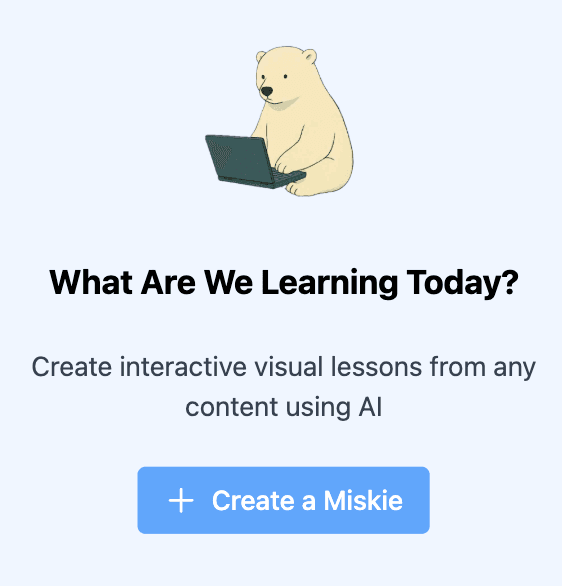
Step 4: Define Your Learning Goal
Be specific about what you want to master:
- Concept name: "Understanding Neural Networks"
- Learning objective: "Learn what neural networks are and how they work"
- Time commitment: "20 minutes to grasp basics"
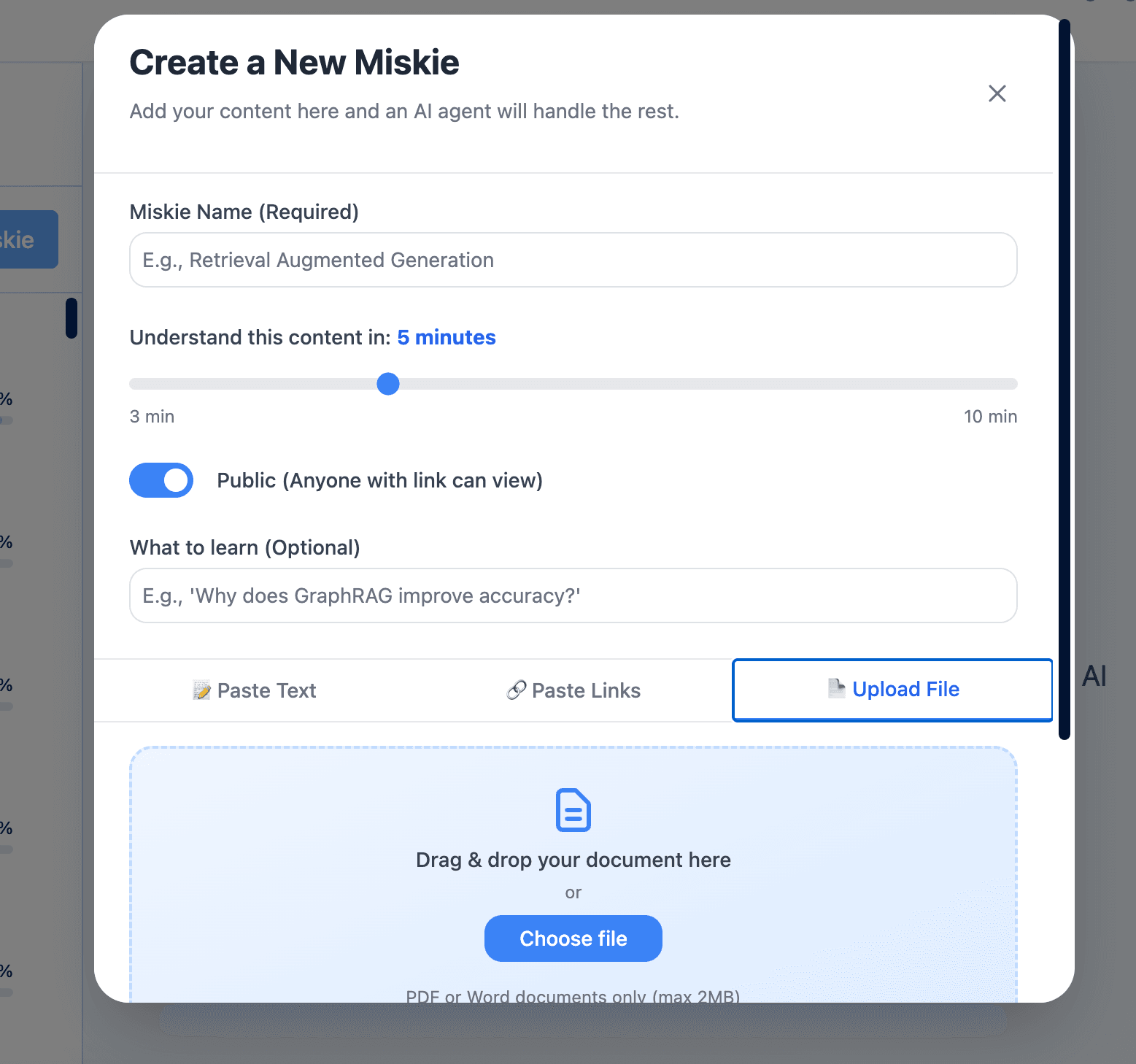
Step 5: Add Your Learning Materials
Upload or paste your resources:
- Tutorial articles about the concept
- Beginner-friendly explanations
- Introduction chapters from books
- Online course materials
- Documentation pages

Step 6: Study AI-Generated Slides
In 30 seconds, receive structured visual slides:
Introduction Slides that set the foundation:
- What is this concept?
- Why does it matter?
- Where is it used?
Core Concept Slides with visual explanations:
- Key principles illustrated with diagrams
- Relationships shown visually
- Processes explained step-by-step
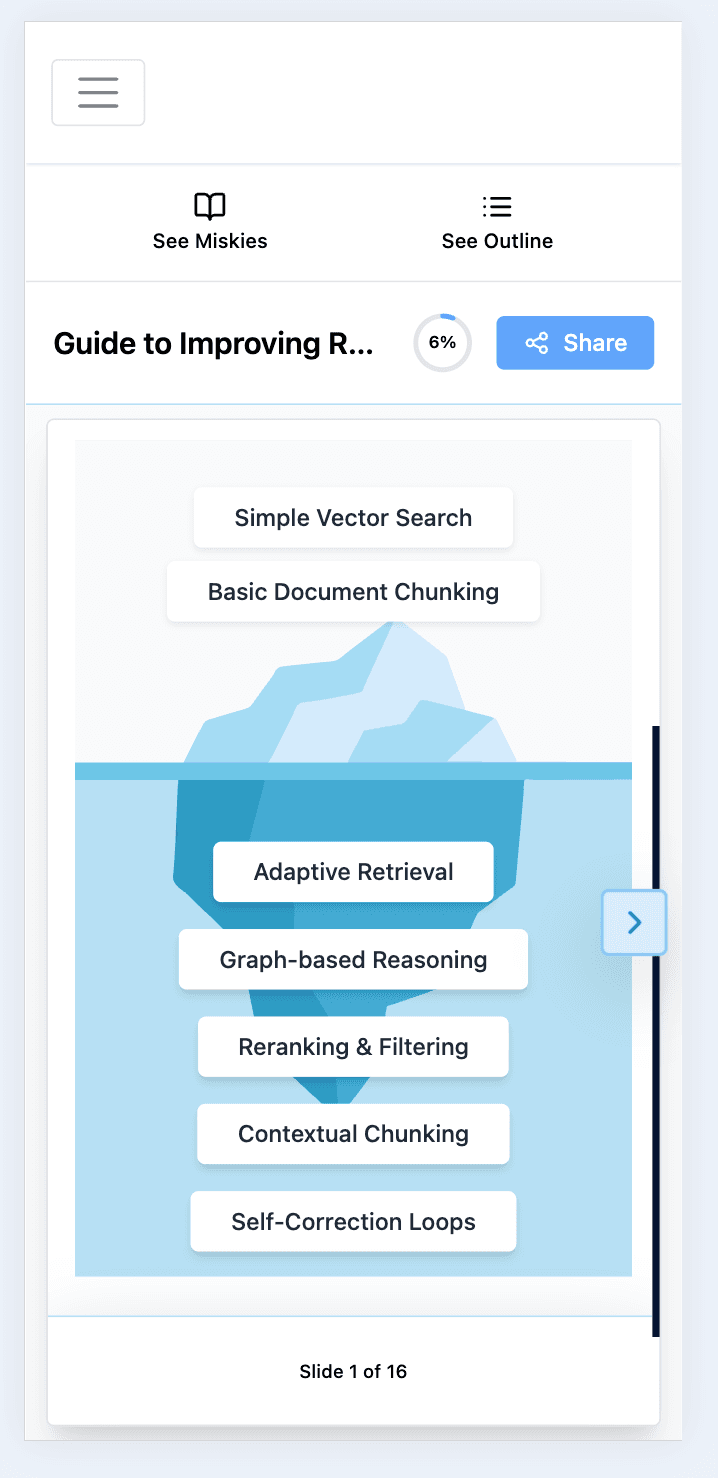
Advanced Understanding Slides:
- Deeper dive into important aspects
- Connections to related concepts
- Nuances and exceptions
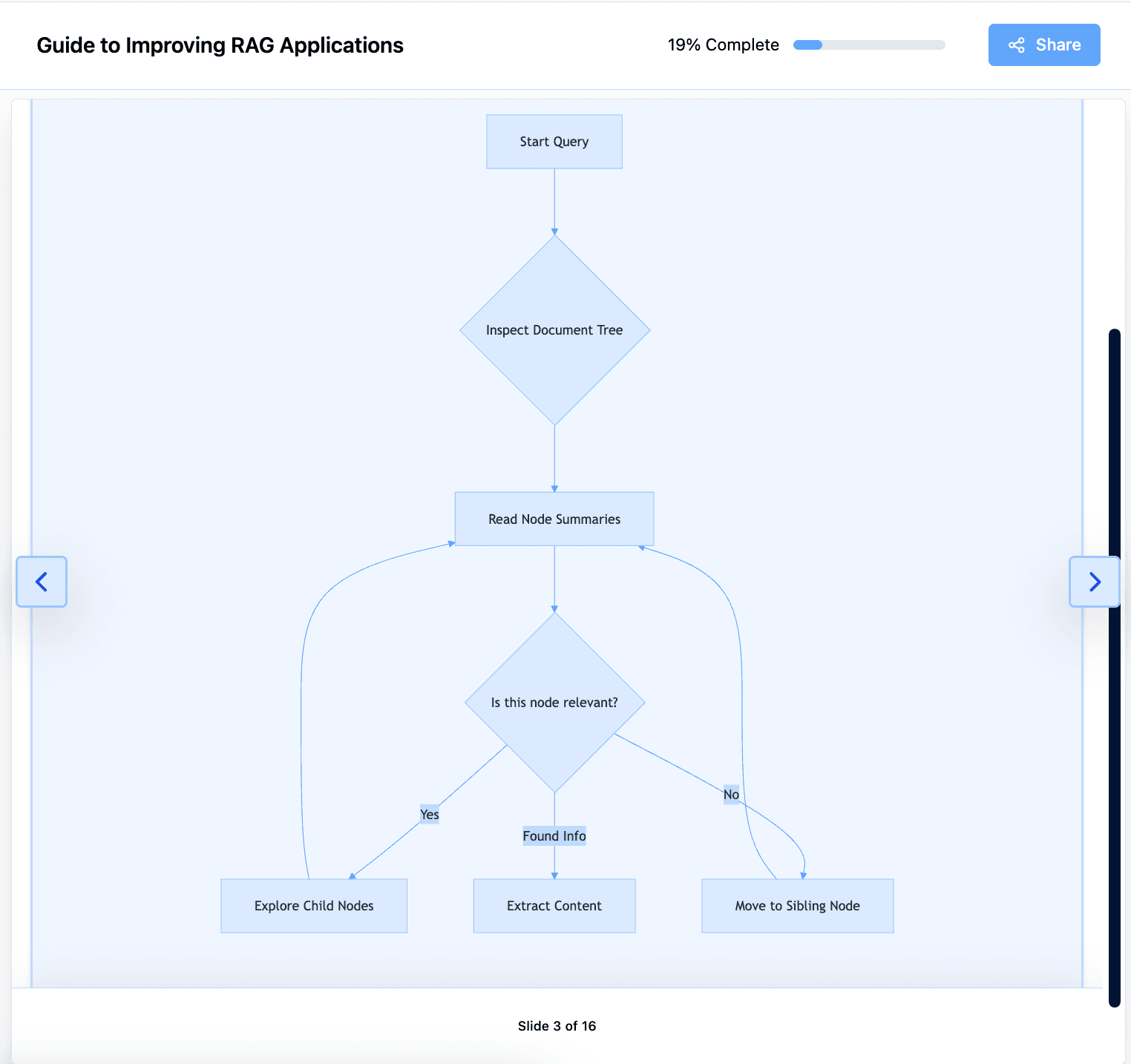
Practice Slides for active learning:
- Hands-on exercises
- Application scenarios
- Knowledge checks
- Concept quizzes
Types of Diagrams for Different Concepts
Hierarchical Concepts
Example: Biological classification, corporate structure, software architecture
Diagrams generated:
- Pyramid diagrams showing levels
- Tree structures showing relationships
- Organizational charts
Process-Based Concepts
Example: Chemical reactions, project workflows, historical events
Diagrams generated:
- Flowcharts showing steps
- Sequence diagrams showing progression
- Timeline visualizations
Comparative Concepts
Example: Programming languages, historical periods, market segments
Diagrams generated:
- Venn diagrams showing overlaps
- Comparison tables
- Scale diagrams showing differences
Systematic Concepts
Example: Economic systems, ecosystems, business models
Diagrams generated:
- Flywheel diagrams showing cycles
- System interaction maps
- Feedback loop visualizations
Layered Concepts
Example: OSI model, learning theories, marketing funnels
Diagrams generated:
- Iceberg diagrams (visible vs hidden)
- Layer stack visualizations
- Depth progression diagrams
Real-World Concept Mastery Examples
Example 1: Learning Blockchain Technology
Traditional approach:
- Read 50-page whitepaper (4 hours)
- Still confused about how it works
- Can't explain to others
AI-generated slides approach:
- Upload blockchain tutorial article
- Receive 15 visual slides in 30 seconds
- Slide 1: What is blockchain (simple definition)
- Slide 2: Key components diagram
- Slide 3: How transactions work (flowchart)
- Slide 4: Consensus mechanism visual
- Slide 5: Security features diagram
- Slides 6-8: Use cases with examples
- Slides 9-10: Advantages/disadvantages comparison
- Slides 11-15: Practice exercises and quizzes
Result: Understand basics in 15 minutes, can explain concept confidently.
Example 2: Learning Design Thinking
Traditional approach:
- Read design thinking book (6 hours)
- Vague understanding of process
- Unsure how to apply
AI-generated slides approach:
- Upload design thinking guide
- Receive visual process breakdown
- Sequence diagram of 5 stages
- Examples for each stage
- Practice scenario exercises
- Application to real problems
Result: Clear process understanding in 10 minutes, ready to apply.
Example 3: Learning Regression Analysis
Traditional approach:
- Statistics textbook chapter (3 hours)
- Confused by formulas
- Don't see practical use
AI-generated slides approach:
- Upload regression tutorial
- Visual formula breakdowns
- Step-by-step calculation flowcharts
- Real dataset examples
- Practice problems with guidance
Result: Understand concept and can perform analysis in 25 minutes.
Strategies for Concept Mastery
The Foundation-First Strategy
Step 1: Start with absolute basics
- What is it? (definition)
- Why does it exist? (purpose)
- Where is it used? (context)
Step 2: Build core understanding
- How does it work? (mechanism)
- What are key components? (structure)
- What are main principles? (fundamentals)
Step 3: Add depth and nuance
- When is it applied? (use cases)
- What are variations? (types)
- What are limitations? (boundaries)
Step 4: Practice application
- Solve practice problems
- Apply to scenarios
- Create own examples
The Connection Strategy
Link new concepts to what you already know:
Create slides for:
- New concept explanation
- Similar concept you know
- Comparison between both
- Unique aspects of new concept
Result: Faster learning through analogies.
The Multi-Source Strategy
Build comprehensive understanding:
Combine materials:
- Beginner tutorial (accessibility)
- Academic source (depth)
- Practical guide (application)
- Expert explanation (nuance)
Generate slides from all:
- More complete understanding
- Multiple perspectives
- Richer comprehension
The Progressive Complexity Strategy
Master in stages:
Week 1: Basic understanding
- Introduction slides only
- Simple exercises
- High-level concepts
Week 2: Intermediate depth
- Detailed mechanism slides
- More complex exercises
- Connected concepts
Week 3: Advanced application
- Edge cases and nuances
- Real-world scenarios
- Expert-level understanding
Best Practices for Fast Mastery
1. Start Simple
Don't overwhelm yourself:
- Choose beginner-friendly sources
- Focus on one aspect at a time
- Build progressively
2. Use Visual Memory
Leverage diagram power:
- Study visual slides carefully
- Redraw key diagrams
- Visualize concepts mentally
3. Practice Immediately
Don't skip exercises:
- Complete all practice problems
- Apply to own scenarios
- Test yourself with quizzes
4. Teach Others
Best way to verify mastery:
- Explain concept using slides
- Share with friends or colleagues
- Answer their questions
5. Review Regularly
Spaced repetition for retention:
- Review after 1 day
- Review after 3 days
- Review after 1 week
- Review before applying
Building Your Concept Library
Create Collections by Domain
Technology Concepts:
- Programming paradigms
- Software architecture patterns
- Data structures and algorithms
- System design principles
Business Concepts:
- Strategic frameworks
- Marketing models
- Financial principles
- Management theories
Science Concepts:
- Physical principles
- Chemical processes
- Biological systems
- Mathematical theories
Humanities Concepts:
- Philosophical schools
- Historical movements
- Literary techniques
- Social theories
Organize by Learning Stage
Beginner Level:
- Basic definitions
- Simple examples
- Core principles
Intermediate Level:
- Detailed mechanisms
- Complex examples
- Related concepts
Advanced Level:
- Edge cases
- Expert applications
- Deep nuances
Sharing Your Learning Journey
Help Others Learn
When you master a concept:
- Share your slides with community
- Help beginners understand
- Build learning resources together

Discover How Others Learned
Browse community slides: https://www.miskies.app/miskies/explore
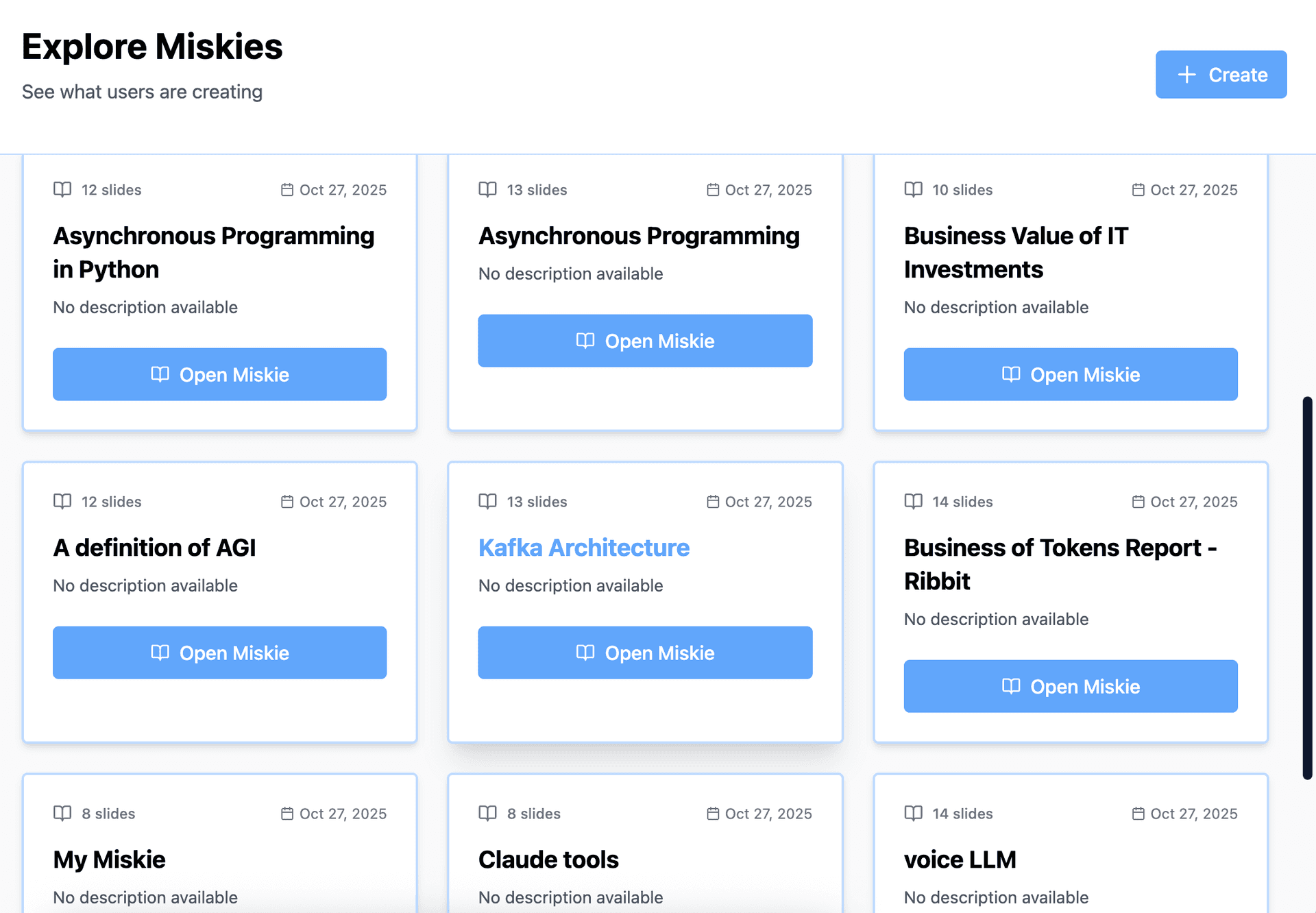
Find:
- Different explanation approaches
- Alternative visual styles
- Additional practice problems
- Expert insights
Measuring Your Mastery
Self-Assessment Questions
After studying AI-generated slides, ask:
- ✅ Can I explain this concept simply?
- ✅ Can I draw the key diagrams from memory?
- ✅ Can I provide real-world examples?
- ✅ Can I solve practice problems independently?
- ✅ Can I teach this to someone else?
If yes to all: You've mastered the concept!
Application Test
True mastery means application:
- Use concept in real project
- Solve novel problems with it
- Make decisions based on it
- Recognize it in the wild
Common Learning Mistakes to Avoid
❌ Trying to learn everything at once ✅ Master one concept thoroughly before moving on
❌ Skipping practice exercises ✅ Active application essential for mastery
❌ Not reviewing after initial learning ✅ Spaced repetition prevents forgetting
❌ Relying only on passive reading ✅ Visual slides + practice = real understanding
❌ Learning in isolation ✅ Discuss with others, share understanding
From Beginner to Expert
Timeline for Concept Mastery
Day 1: Introduction
- Generate and review slides (15 min)
- Complete basic exercises (10 min)
- Understand core ideas
Day 3: Reinforcement
- Quick slide review (5 min)
- Try application problems (15 min)
- Solidify understanding
Day 7: Deepening
- Review advanced slides (10 min)
- Tackle complex scenarios (20 min)
- Build confidence
Day 14: Integration
- Brief refresher (5 min)
- Apply to real projects
- Teaching-ready mastery
Why AI-Generated Slides Accelerate Learning
Compared to Traditional Methods:
Reading Textbooks:
- ⏰ 3-5 hours for new concept
- 📖 Passive reading only
- 😴 Information doesn't stick
- 🤷 Unclear what's important
AI-Generated Slides:
- ⚡ 15-25 minutes for mastery
- 🎯 Active visual learning
- 🧠 Strong retention
- ✨ Key points highlighted
Start Mastering New Concepts Today
Stop spending hours confused by new concepts. Use AI-generated visual slides to master any topic quickly and effectively.
Visit Miskies AI and start learning your first new concept in 30 seconds.
100% Free • Unlimited Concepts • Learn Anything Faster
Every expert was once a beginner. The difference? They found effective ways to learn.
Keywords: learn new concepts, master new topics, AI learning slides, concept mastery, learn faster, understand new ideas, AI study tool, concept visualization, quick learning, beginner learning, AI-generated lessons, visual concept learning